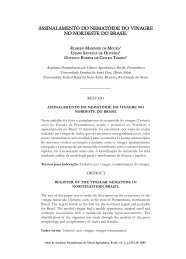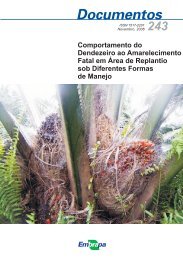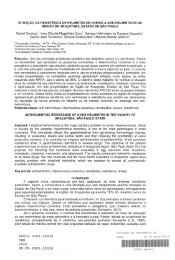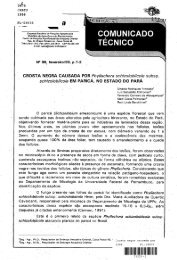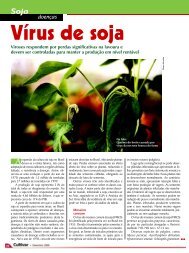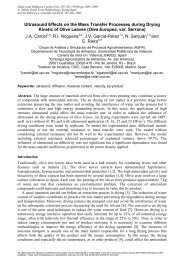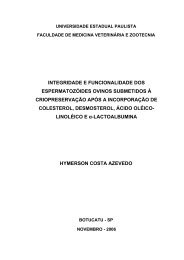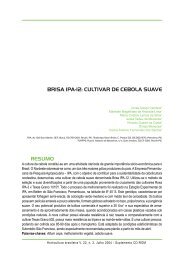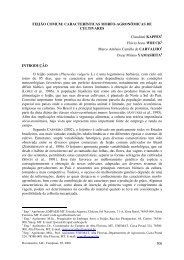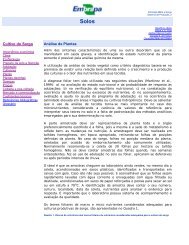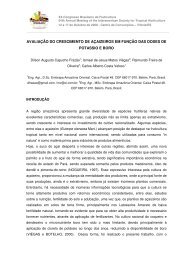Guarana´'s Journey from Regional Tonic to Aphrodisiac and ... - Ainfo
Guarana´'s Journey from Regional Tonic to Aphrodisiac and ... - Ainfo
Guarana´'s Journey from Regional Tonic to Aphrodisiac and ... - Ainfo
Create successful ePaper yourself
Turn your PDF publications into a flip-book with our unique Google optimized e-Paper software.
280 Guarana´—<strong>Regional</strong> <strong>to</strong> global<br />
the Sateré-Maue´ (then known as the Andirazes) valued<br />
guaraná as much as Europeans did gold because the<br />
drink gave them ‘so much energy, that when hunting,<br />
they could go <strong>from</strong> one day <strong>to</strong> the next without feeling<br />
hungry’ (4). Father Betendorf noted that guaraná was<br />
drunk <strong>to</strong> diminish fevers <strong>and</strong> cure headaches, <strong>and</strong> also<br />
served as a powerful diuretic. On the latter he remarked<br />
that ‘With respect <strong>to</strong> its reputation for provoking the<br />
need <strong>to</strong> urinate, I can personally testify.’<br />
During the colonial period, guaraná was sold variously<br />
as a fortifier, stimulant, <strong>to</strong>nic, antidote <strong>to</strong> fever, a preventive<br />
against hardening of the arteries <strong>and</strong> <strong>to</strong> treat<br />
migraines. Guarana´ was deemed especially effective in<br />
treating diarrhea <strong>and</strong> dysentery (5,6). But as with any<br />
product, overindulgence can trigger problems. Over two<br />
centuries ago, Francisco Xavier Ribeiro de Sampaio,<br />
a Brazilian judge, warned that excessive drinking of<br />
guaraná can lead <strong>to</strong> insomnia <strong>and</strong> even impotence (7).<br />
In the middle of the 18th century while visiting Santarém<br />
along the middle Amazon, the fourth Bishop of Bele´m,<br />
Dom Joa˜o de Sa˜o Jose´ de Queiro´s da Silveira greatly<br />
appreciated guarana´ but warned that excessive consumption<br />
could lead <strong>to</strong> insomnia or dizziness (8).<br />
Cultivation <strong>and</strong> Processing<br />
Guarana´ is grown on small <strong>and</strong> large farms, either as a<br />
monocrop or alongside other crops. Guarana´ is harvested<br />
by h<strong>and</strong> in the dry season. If the entire fruit bunch is<br />
ripe, it is either snipped off with scissors or small pruning<br />
shears, or broken off manually. If only a few berries are<br />
ripe, they are picked individually. The guaraná fruits<br />
are then placed in a basket <strong>and</strong> carried back <strong>to</strong> the home.<br />
Before roasting the seeds, the red skin must be removed.<br />
The fruits are skinned by h<strong>and</strong>, left <strong>to</strong> soak in water,<br />
or simply s<strong>to</strong>red for several days until the skin softens.<br />
On small farms in the Maue´s watershed, guaraná seeds<br />
are roasted on a griddle, preferably of clay <strong>to</strong> reduce the<br />
chances of burning. Clay griddles are about two meters<br />
in diameter <strong>and</strong> are made at various households along<br />
the Maue´s <strong>and</strong> some of its affluents, wherever suitable<br />
clay is found. Guarana´ seeds are roasted in an open-sided<br />
hut, but it is hot work <strong>and</strong> it takes several hours. Women<br />
roast guaraná in Satere´-Maue´ society; they periodically<br />
s<strong>to</strong>p stirring the seeds <strong>to</strong> pick some up <strong>and</strong> smell them <strong>to</strong><br />
see if they are ready <strong>to</strong> come off the griddle. The <strong>to</strong>asted<br />
seeds are then pounded in a wooden mortar, mixed with<br />
water <strong>and</strong> then molded in<strong>to</strong> cylinders (basta˜o) before<br />
drying in the sun. They are then smoked in specialized<br />
huts for several weeks <strong>to</strong> impart a unique flavor. The<br />
smoked cylinders last up <strong>to</strong> a year, whereas powdered<br />
guaraná loses some of its flavor after a few months (9).<br />
Industrial plants grind the roasted beans with machinery<br />
similar <strong>to</strong> that used for processing coffee.<br />
Evolution of Guaraná Beverages in Brazil<br />
To prepare the traditional guarana´ beverage, the hard<br />
cylinder is grated with the bony <strong>to</strong>ngue of the pirarucu<br />
(Arapaima gigas), one of the largest fish in the Amazon,<br />
or a small piece of flat rough s<strong>to</strong>ne, such as s<strong>and</strong>s<strong>to</strong>ne<br />
(10). The powder either collects on a piece of paper or<br />
falls directly in<strong>to</strong> a calabash gourd containing water. The<br />
Satere´-Maue´ call the tan-colored guarana´ drink çapo´ (11).<br />
In Sateré-Maue´ culture, only women prepare guarana´<br />
for drinking, whereas among non-indigenous folk, both<br />
men <strong>and</strong> women grate the cylinders. For more formal<br />
occasions, the Sateré-Maué use a small, hour glassshaped<br />
st<strong>and</strong> (patuai), fashioned <strong>from</strong> forest vines,<br />
<strong>to</strong> support the calabash bowl when grating guaraná.<br />
The host <strong>and</strong> guests then pass the bowl around <strong>and</strong><br />
periodically place it back on the st<strong>and</strong>. Urban <strong>and</strong> rural<br />
folk in the Maués watershed typically take guarana´ upon<br />
rising <strong>and</strong> wait an hour or two before a breakfast<br />
of black coffee <strong>and</strong> crackers or bread.<br />
Guarana´ was transformed <strong>from</strong> an elixir <strong>and</strong><br />
home-prepared beverage <strong>to</strong> a mass-produced soda<br />
in the early 20th century. The emergence of ice-making<br />
machines further propelled the soda industry in Brazil<br />
<strong>and</strong> elsewhere in the early 1900s. Sa˜o Paulo-based<br />
Antarctica that merged in 1999 with Brahma <strong>to</strong> form<br />
AmBev <strong>and</strong> was in turn purchased by InBev, a Belgian<br />
company, in 2003, introduced carbonated guarana´<br />
<strong>to</strong> Brazilians in 1909. At first, guaraná soda was sold<br />
mainly in southern Brazil, but many independent bottlers<br />
began making their own versions all over Brazil. In the<br />
Brazilian states of Amazonas <strong>and</strong> Bahia, guarana´<br />
pushups became popular among poorer folk in urban<br />
areas as soon as refrigeration became widespread in the<br />
mid-20th century known as dindin or chopp.<br />
Emergence of Guaraná as an <strong>Aphrodisiac</strong><br />
In the last decade or so, guarana´ carts have begun<br />
appearing in some street markets in the Brazilian<br />
Amazon, such as Bele´m, Abaetetuba, Manaus <strong>and</strong><br />
Manacapuru. Such carts sell guaraná beverages prepared<br />
in a blender with crushed ice. The formula for the energy<br />
drink varies among vendors, but generally contains nuts,<br />
such as cashew, peanuts or Brazil nuts, powdered milk,<br />
aphrodisiac roots or barks <strong>and</strong> guaraná powder or syrup.<br />
Some add fruit, such as avocado or raw quail eggs.<br />
Guarana´ smoothies prepared on ambulant carts as well<br />
as in some cafe´s in the Brazilian Amazon are uplifting<br />
<strong>and</strong> fulfilling, similar in texture <strong>and</strong> effect <strong>to</strong> a<br />
frappuccino served in espresso cafe´s in North America.<br />
One company has also employed guaraná in a<br />
concoction with ‘love herbs for good staying power’.<br />
It contains a ‘mixture of exotic South American<br />
herbs’, including damiana (Turnera diffusa Willdenow<br />
et Schultes; a Central American herb used <strong>to</strong> make



